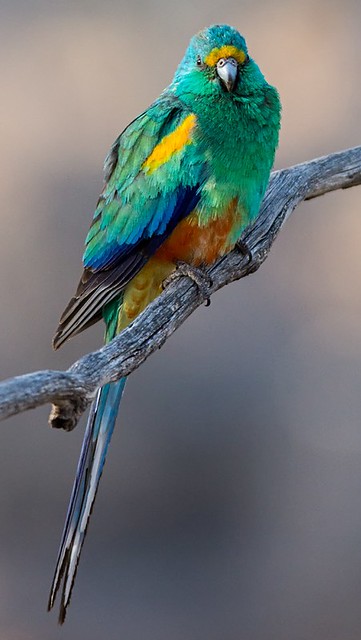Bird beaks feeling the heat of climate change, say scientists
 Thursday, May 28, 2015 at 12:15
Thursday, May 28, 2015 at 12:15  Mulga Parrot (Psephotus varius) Gluepot Reserve, South Australia, Australia. Male. Image by David Cook Wildlife PhotographyWhile the human population grapples with ways to counter the effects of climate change, Deakin University research has discovered that birds might have been working on their own solution for the past 145 years – grow bigger beaks.
Mulga Parrot (Psephotus varius) Gluepot Reserve, South Australia, Australia. Male. Image by David Cook Wildlife PhotographyWhile the human population grapples with ways to counter the effects of climate change, Deakin University research has discovered that birds might have been working on their own solution for the past 145 years – grow bigger beaks.
The scientists, led by Dr Matthew Symonds, have discovered a pattern between increased climatic temperatures and an increase in the size of the beaks of parrot species in southern and eastern Australia.
"Birds use their beaks to keep themselves cool. Just as an elephant's ears help to act as a fan to keep the animal cooler, birds can pump blood to their highly vascularized bills, enabling them to lose excess heat when they get hot," Dr Symonds said.
The researchers examined 410 bird skins, collected between 1871 and 2008 and located at Museum Victoria, the Queensland Museum, the South Australian Museum and the Australian National Wildlife Collection, Canberra.
They found that four of the five species examined had measurably bigger beaks now than they had in the 19th Century.
"In an earlier study we found that birds in hotter climates had bigger beaks than those in cooler climates, which prompted us to look at whether there has been an increase in beak size generally as the climate has got hotter over the past century," Dr Symonds said.
"We found an increase in beak surface area of between four and 10 per cent, which may not sound like much, but would actually make a huge difference to the birds' ability to cool down when they are stressed by heat."
Dr Symonds, an ecologist from Deakin's Centre for Integrative Ecology, within the School of Life and Environmental Sciences, said the research was the first evidence suggesting a link between birds' beak size and climate change, but that more work needed to be done to conclusively establish the link.
"We have been able to show there has been an increase in the size of the beaks, in line with the increase in the temperature these parts of Australia have experienced over the same time frame," he said.
"However, we can't yet conclusively rule out the effect of other environmental factors, such as changes in habitat or food availability.
"This work provides an important basis on which to do more research. The next step will be to expand the research to consider a wider range of species from other regions, and with different kinds of beak shapes and lifestyles.
"Aside from it indicating another way in which climate change is affecting animals, the beak is so intimately tied to a birds' lifestyle that climate-related changes in beaks may have further ramifications for other aspects of their biology: what kind of food they eat, how they compete with each other and how they reproduce."
The five native Australian parrot species examined were the mulga parrot (Psephotus varius), gang-gang cockatoo (Callocephalon fimbriatum), red-rumped parrot (Psephotus haematonotus), Australian king parrot (Alisterus scapularis) and crimson rosella (Platycercus elegans). The Australian king parrot was the only species where an increase in beak size was not recorded.
The research, "Climate-related spatial and temporal variation in bill morphology over the past century in Australian parrots", has been published in this month's edition of the Journal of Biogeography.

